dydx "betrays" Ethereum, will application chains become the mainstream narrative for Dapps?
Author: Ans, Krypital Group
Editor: Krypital Group
On June 22, dydx announced its separation from Starkware and will choose to develop a dydx chain based on the Cosmos SDK. Additionally, it is proposed that DYDX be used as the native token for dYdX v4 (which will ultimately depend on the community).
As the Dapp application with the largest TVL on L2, dydx's actions undoubtedly pour cold water on the currently hottest Ethereum L2, sparking intense discussions within the dydx, Ethereum, and Cosmos communities, mainly focusing on:
1. Why did dydx "betray" Ethereum?
2. Can App Chains, or application chains, become the mainstream narrative for Dapps in the future?
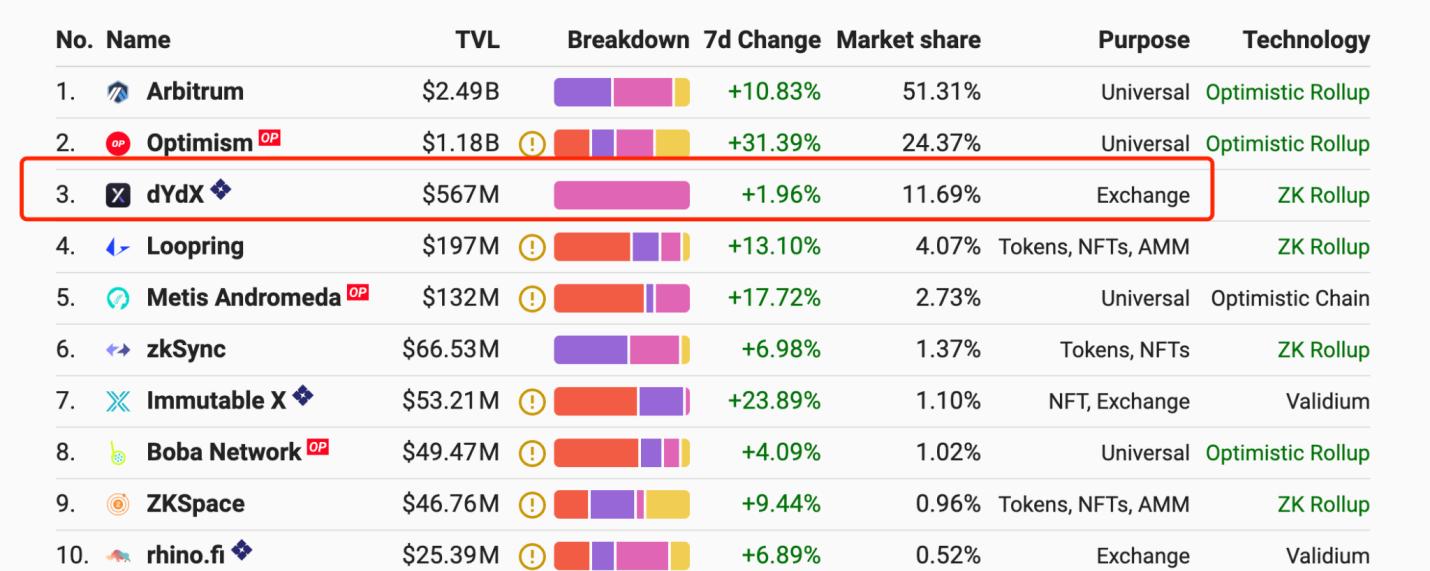
(The above data is from L2Beat)
This is also the main topic of this article. As application chains on Cosmos have already taken shape, many excellent success stories have emerged. This article will primarily focus on examples from the Cosmos ecosystem.
1: Why did dydx abandon Ethereum?
1. The centralization issue of L2 sequencers
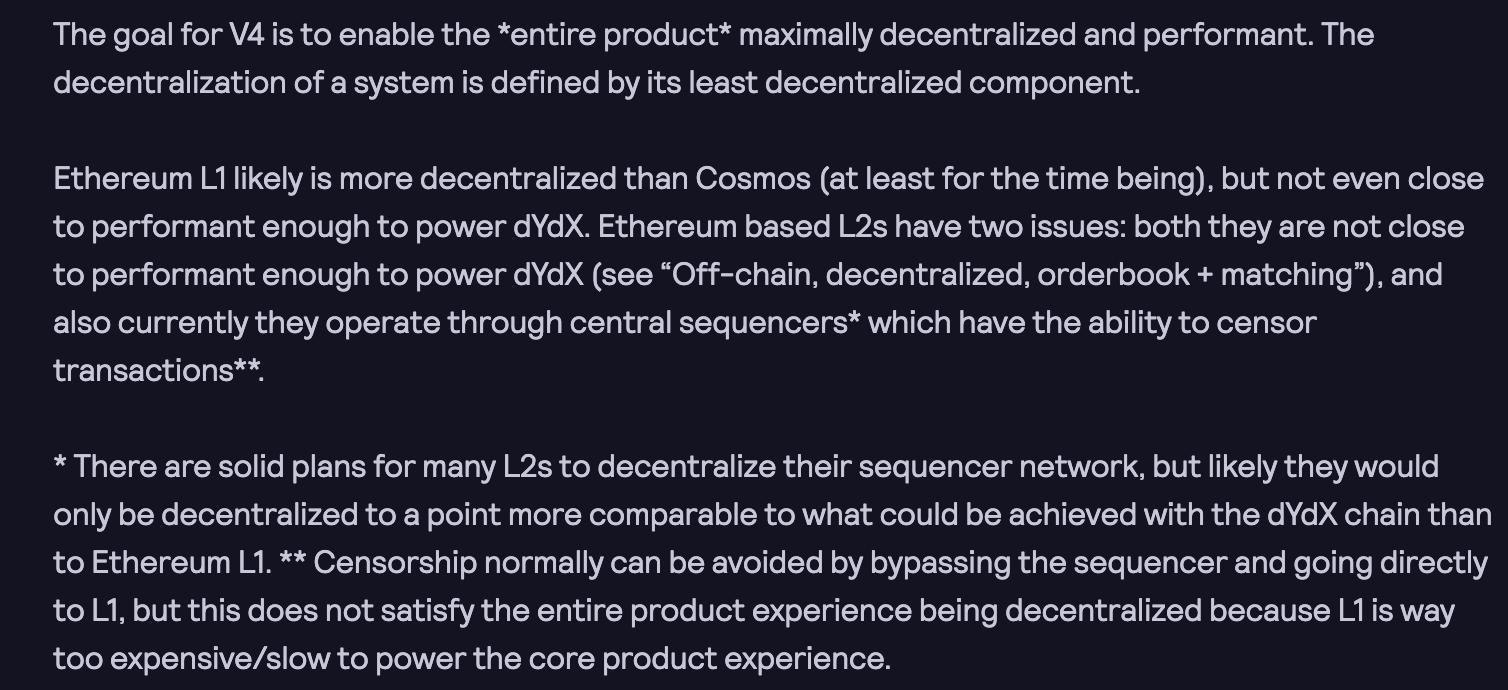
L2 is a solution to the scalability problem of Ethereum, and it is widely accepted that Rollup is currently the best solution for L2. We all know that L2's block storage is on Ethereum, and the entity responsible for ordering, batching, and submitting transactions to L1 is the sequencer.
On the Ethereum mainnet, we pay gas to miners, while on L2, we pay gas to sequencers. Since sequencers determine the order of transactions, they can profit by extracting MEV. Therefore, decentralizing sequencers to resist censorship is very important.
However, currently, the sequencers on rollups are operated by single entities. For example, Offchain Labs and Optimism PBC are the sole operators of the sequencers for Arbitrum and Optimism, respectively. StarkNet is currently the same. This will become a significant obstacle for dydx as it moves towards fully decentralized derivatives.
Although these L2s plan to decentralize sequencers in the future, as the ecosystem grows and reaches a certain scale, they will still face the issue of multiple applications competing for the same network resources. In 2021, when gamefi and airdrop farming were popular, Polygon often saw gas prices soar dozens of times just to package transactions, and Solana outages became a daily occurrence. During that time, BSC also had several popular gamefi and defi projects that frequently clogged the network, and this was not an isolated incident; it was a common occurrence throughout the year, becoming a routine for BSC mining players.
Moreover, the market may overestimate the scalability of L2 rollups.
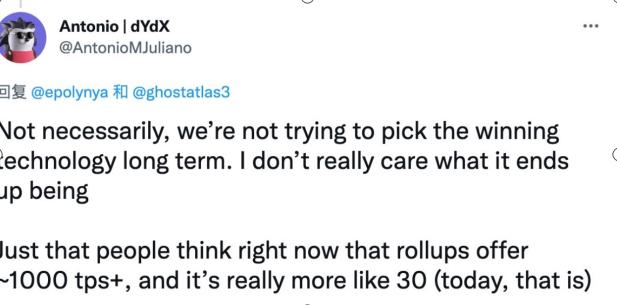
(The above information is sourced from dydx founder Antonio's Twitter)
Antonio, the founder of dydx, expressed a pessimistic view on the future scalability of rollups on Twitter, stating that dYdX is currently the largest dapp on rollups and understands rollups very well. The goal of dYdX is to become ten times its current scale and to compete with centralized trading platforms in terms of user experience.
Antonio has previously expressed similar sentiments, indicating that Ethereum's slow technological iteration has limited the development of its dapps.
I personally agree with this, as the decentralization of L2 sequencers will take a long time. After several years of delays, Ethereum finally set the Merge for the end of the year, while Danksharding and ZK-Rollup are expected to take until next year, and ZKEVM and DAMM (cross-L2 AMM solutions) are still in the exploratory stage.
2. Current Ethereum infrastructure cannot meet business customization needs.
On Twitter, a Solidity developer, 0xTomoyo, deeply analyzed the reasons for the migration from a technical perspective.
Currently, the dYdX order book operates on a single server off-chain, with L2 only used for settlement of matched trades. Theoretically, they could build an order book with memory on L2, but such tools do not currently exist. Therefore, dYdX chose to build a new chain on Cosmos, allowing each validator to run a memory order book. This further achieves decentralization of the protocol.
3. Considerations of chain sovereignty
Antonio responded that the migration does indeed consider chain sovereignty, as having a dedicated chain for dYdX will make it easier for the protocol to recover from vulnerabilities or hacker attacks (it can be forked). In terms of security, the new chain will initially control the number of nodes to ensure safety.
When certain projects on-chain encounter serious issues, sidechain or Layer 2 teams usually initiate proposals to roll back or freeze.
For example, when eco announced the freezing of nodes, ddex was hacked, and the wallet containing the stolen funds was frozen. In similar situations, once transaction infections occur, the rights of users of their dapp are often affected.
Another case is that during the upgrade maintenance of Polygon last year, it would not be postponed because your dapp was holding an event.

(The above information is sourced from: Cointelegraph Chinese)
For dapps like dydx that require timely liquidation, untimely upgrade operations will undoubtedly cause a lot of trouble for users.
This is also why many people are hesitant to use leveraged or lending products on Solana; when Solana crashes, if you have positions, you cannot operate and can only watch them liquidate. For projects with higher TVL, they are less willing to put their products and users in such a passive situation. Once dydx has its own chain, it will have greater control over protocol upgrades, security, and the normal operation of products.
Having its own chain will also empower the dydx token more, whether as mainnet gas, better integration into products, or governance aspects, bringing greater rights to dydx token holders. Currently, the dydx mainnet is on SterEx, while the token is still on the ETH mainnet, separating the protocol from the token. After an initial rise, the token's market value has been declining, which poses a significant challenge for the dydx team and community.
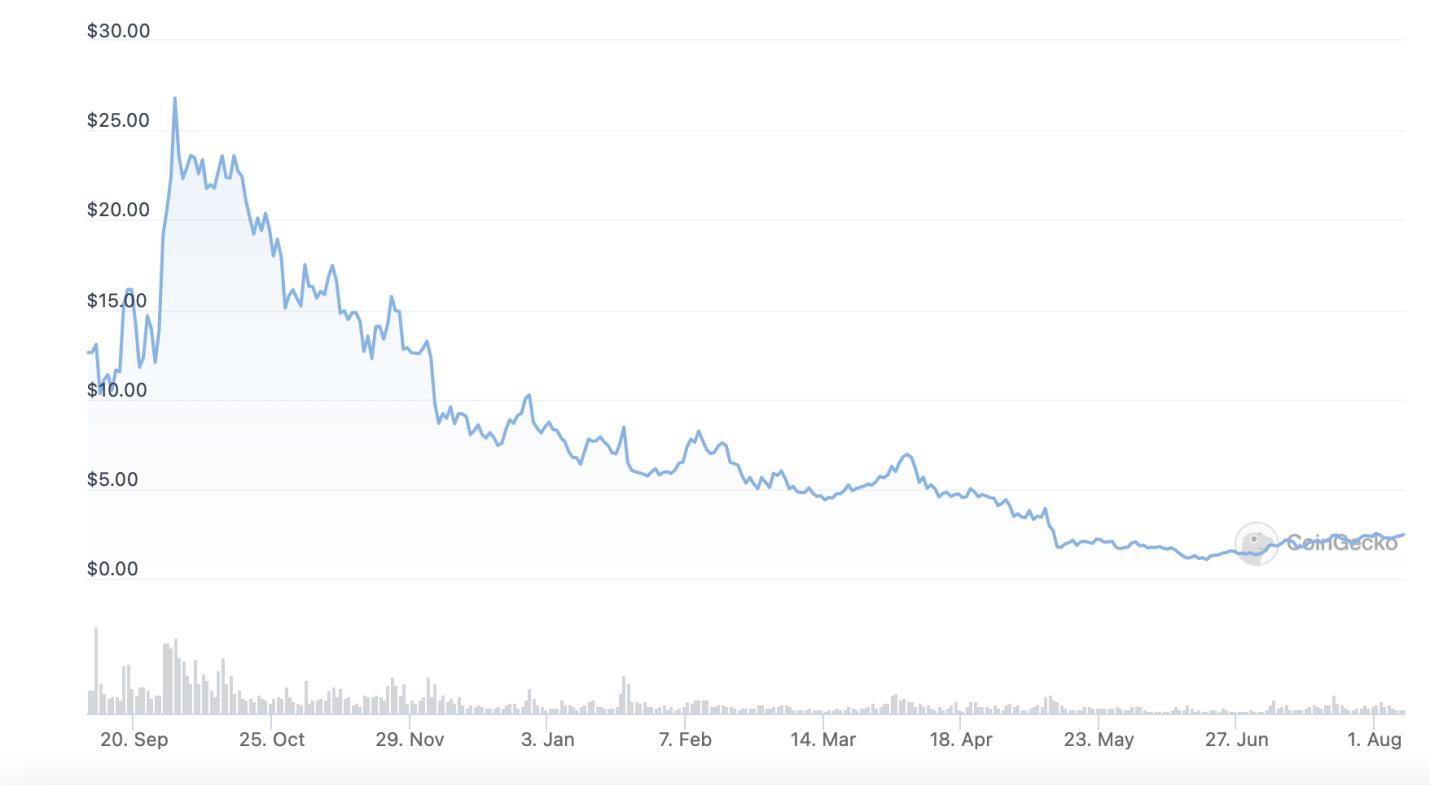
(The above data is sourced from: Coingecko)
4. Regulation
The regulatory pressure on dex and DeFi is increasing. As mentioned earlier, the current dYdX order book actually operates on a single server off-chain, and this "semi-decentralized" exchange will still face unclear regulatory issues in the future.
Previously, the mixing protocol Tornado stated under pressure that it would block wallet addresses sanctioned by the OFAC. Last year, Uniswap also received regulatory requests from the SEC to block certain securities tokens from being traded by Americans. However, DeFi cannot block American IPs at the smart contract level. So currently, Uniswap.org only blocks many token permissions at the front-end UI layer for American IPs, but there are many community versions of the UI. Uniswap itself also has a decentralized version of the UI. Uniswap.eth.link has no restrictions for Americans. Therefore, as dydx further decentralizes, we will certainly see more unrestricted UI front-ends emerge to meet the blockchain community's demand for censorship resistance.
After many BSC chain projects ran away last year, some in the community requested Binance to freeze assets. Binance also claimed "decentralization" through 21 nodes, stating that Binance Smart Chain is a decentralized open-source public chain, and Binance cannot intercept or restrict cross-chain transfers or freeze any on-chain assets. Therefore, in the face of potential regulatory pressure, fully decentralizing the operating nodes and isolating them from the development company is undoubtedly the safest and most in line with blockchain principles.
2: Application Chains as a New Narrative and Development Direction for Dapps
The migration of dydx has also sparked discussions about application chains. We will analyze this from both technical architecture and user scale perspectives.
First, from the technical architecture perspective. Antonio has repeatedly stated that StarkWare's developer support is insufficient, while Cosmos has good developer support. Indeed, in recent years, Cosmos has made significant progress in infrastructure, launching several important modules to enhance cross-chain interoperability.
Inter-Blockchain Communication (IBC)
There are many in-depth articles analyzing the technical principles of the Cosmos IBC module. Here, I will directly quote the conclusion: using the IBC protocol, chains can freely connect with each other, and the security level of cross-chain tokens is close to that of native assets on the native chain. The user experience is also a significant improvement; when using it, we hardly feel that we are conducting cross-chain transactions.
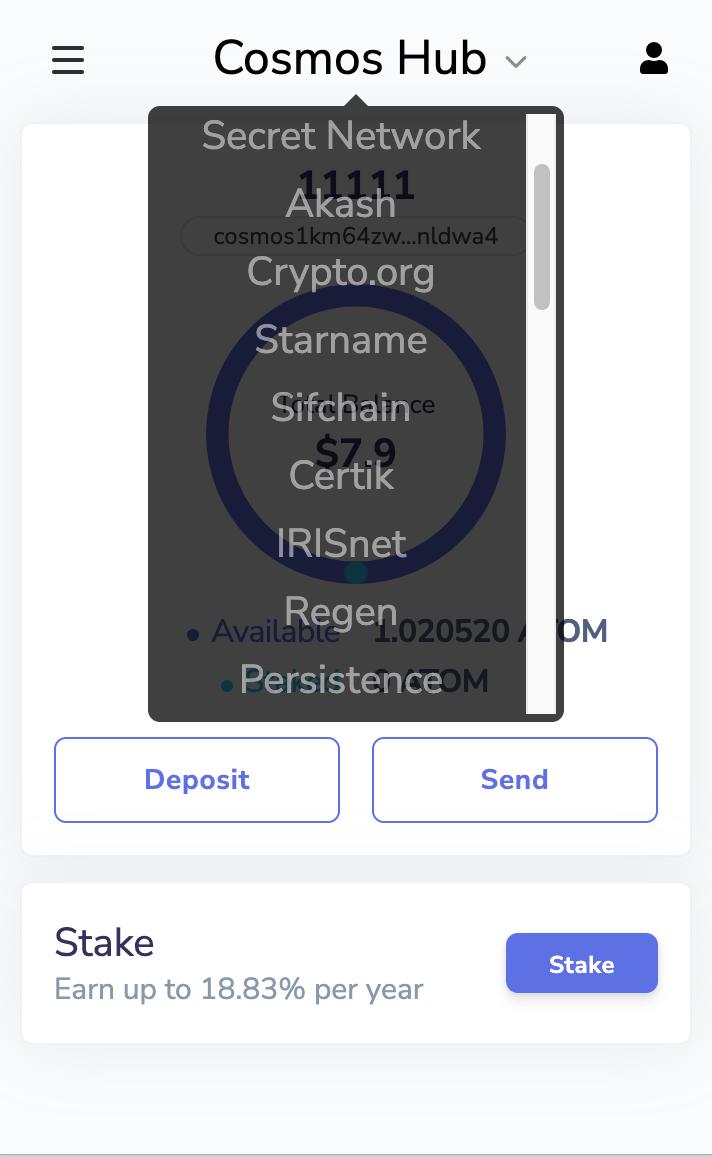
(The largest wallet in the Cosmos ecosystem, Keplr plugin wallet)
Taking Osmosis as an example, let's experience the user experience of IBC cross-chain.
Osmosis is the largest dex chain in the Cosmos ecosystem. By choosing to develop its own underlying architecture, Osmosis has more customization space compared to Uniswap. In addition to privacy trading, MEV resistance, and gas-free features, it has also developed a Superfluid staking mechanism, allowing OSMO tokens in liquidity pools to be staked to protect the network while enjoying PoS staking rewards. This provides triple incentives (trading fees, liquidity mining rewards, PoS staking rewards). The protocol also offers staking as a service to help other application chains (which need to be on the whitelist) gain security. By transforming itself into a SaaS model, it captures value within Cosmos.
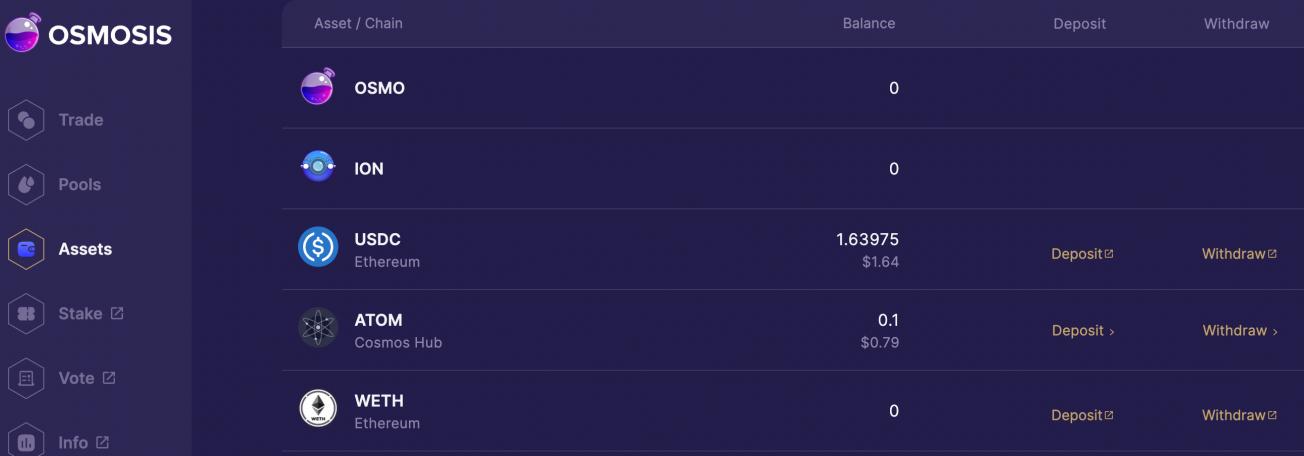
(Osmosis has connected with 38 chains using IBC, covering the vast majority of active chains in the Cosmos ecosystem)
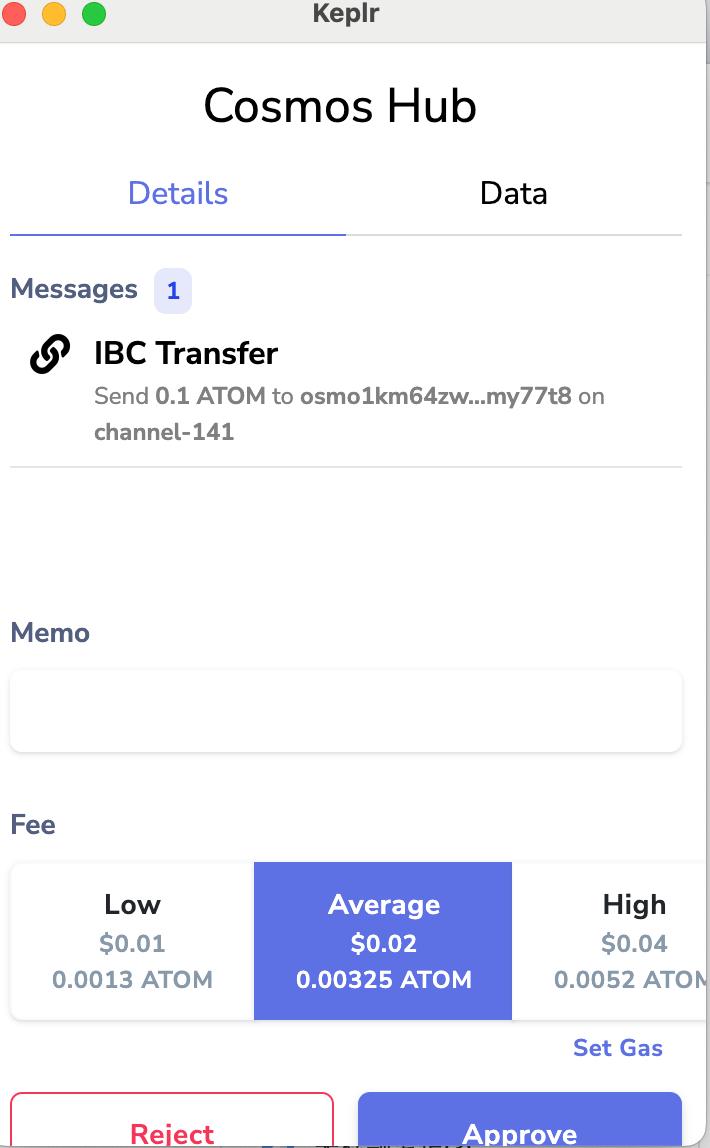
In Osmosis, transferring assets from other appchain chains to Osmosis is called Deposit, while transferring back is called Withdraw; essentially, it utilizes the IBC cross-chain transfer process.
Interchain Accounts
The Interchain Accounts module allows chains to call applications on each other's chains and execute operations on each other's chains. This means that a blockchain that has enabled the interchain accounts module can do more than just cross-chain tokens. It elevates cross-chain interoperability to a new level.
For example, currently, the Aave smart contract on Ethereum cannot operate the swap contract on the Solana chain. However, within an ecosystem that has enabled the interchain accounts module, a chain dedicated to "lending" can call the liquidity of another "trading chain" (Osmosis) for liquidation operations. When different chains can link more deeply through IBC, it can further unleash the potential for DeFi composability.
Interchain Security
This module will go live this year, and I believe it is a particularly important part. We all know that to prevent 51% attacks, PoS chains have relatively high requirements for market value (the cost of running node servers) and token distribution.
Interchain Security is a shared security service that allows chains to effectively share their security, enabling new chains to launch more securely, while validators on larger chains can provide validation node protection for new chains in exchange for rewards. Essentially, new chains can offer a portion of their tokens to validators on mature chains to rent security, similar to how Polkadot's slot leasing allows sharing of another chain's security.
The Cosmos team itself has developed a chain called Cosmos Hub, with the token being atom. It is important to note that other projects developed using the Cosmos SDK can communicate via IBC without going through the Cosmos Hub and do not need to consume atom. Currently, atom is mainly used for developer voting to decide the development direction, and ordinary investors holding the token have no more practical use besides occasionally receiving spontaneous airdrops within the ecosystem.
Once Interchain Security goes live, Cosmos Hub will undoubtedly become the first choice for many new chains seeking to rent security. The launch of cross-chain security services will greatly increase the demand for atom, and for retail investors, staking atom can simultaneously earn token rewards from multiple chains.
On the user level, we also observe that Appchains are feeding back into the Cosmos ecosystem.
For many new projects, during the cold start phase, there aren't many users, so choosing a platform will depend on whether that platform already has a substantial user base. According to current data from the Cosmos official website, its ecosystem already has 266 apps and services, making it the recognized second-largest blockchain ecosystem, second only to Ethereum.

(Cosmos ecosystem diagram)
During the DeFi summer of 2021, aside from Luna, the Cosmos ecosystem also had many EVM-compatible chains, such as Kava and Crypto.org. Through liquidity mining and other methods, these chains attracted a large number of players into the Cosmos ecosystem, which will benefit all chains integrated with IBC connected to the Cosmos ecosystem. For new chains, this is the biggest attraction of choosing the Cosmos ecosystem.
In addition to Cosmos, there are also many successful application chains, cases, and developing application scenarios.
THORChain
THORChain differs from ordinary cross-chain bridges in that it can decentralize the exchange of heterogeneous native assets, such as exchanging BTC for Doge… rather than various wrapped tokens. This is all thanks to THORChain's custom-developed THORNodes, which allow non-smart contract public chains to complete native asset exchanges.
Terrachain
Although the narrative of Luna's stablecoin has failed, its development strategy is undoubtedly an excellent template, choosing its own underlying chain and allowing all applications on-chain to serve the core function of UST, leading to the UST ecosystem reaching a very high scale.
Secret Network
Secret Network was previously a second-layer privacy solution built on Ethereum, originally established in 2017 as "Enigma." To address scalability, it has also migrated its tech stack to the Cosmos SDK.
The Secret application layer currently has dozens of applications, with top applications like SiennaSwap and SecretSwap receiving tens of millions of dollars in funding. Earlier this year, with the support of 25 institutions including DeFiance Capital, Alameda Research, Huobi, and HashKey, a $400 million ecosystem fund was announced, aiming to incubate 100 projects this year.
++https://scrt.network/blog/shockwave-next-phase-secret-network-growth++
In addition, besides Secret, there are also privacy layer 1 protocols developed based on the Cosmos SDK and integrated with IBC, such as Oasis and Nym, which is newly led by a16z and Binance.
Uniswap Chain and Compound Chain
In fact, as one of the first-generation DeFi leaders, Compound was the first to attempt to transform into a dedicated chain dapp. Compound initially chose Polkadot's Substrate. After dydx announced its development of a chain, Compound's CEO also commented on this.
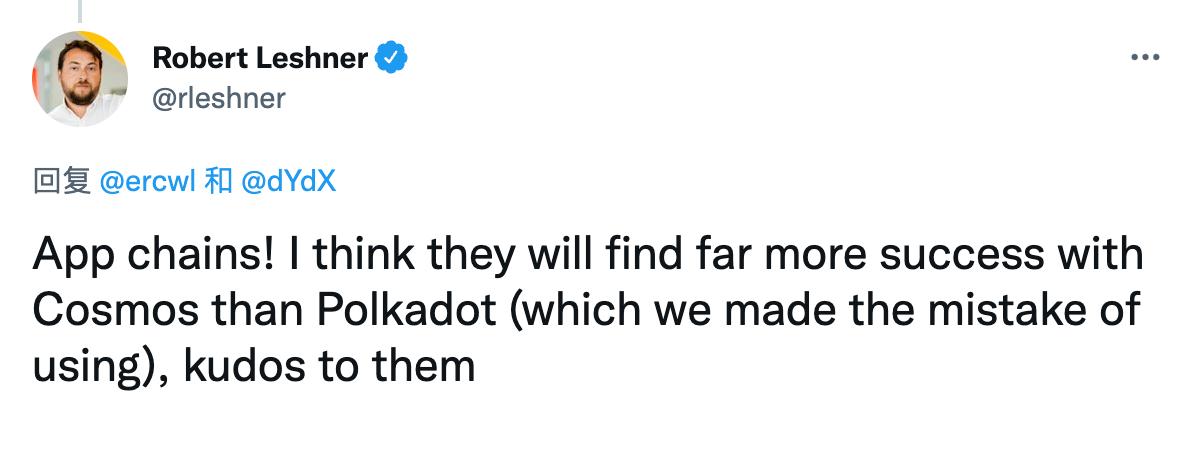
(Compound CEO's Twitter reply)
They claimed that choosing Substrate led to detours that caused their chain to be repeatedly delayed, but they did not specify the specific issues with Substrate. However, they are indeed attempting to create application chains.
A topic that is hotly discussed in the Uniswap community is whether Uniswap will launch Uniswap Chain. Although Uniswap has not officially announced this plan, it is noteworthy that Uniswap founder Hayden has been quite active in discussions on this topic, seeming to have a more open attitude towards it.
If dydx can successfully migrate and achieve greater success on dydx than on Ethereum, it will provide significant incentives for Uniswap, Compound, or other applications looking to build their own application chains, promoting them to move faster towards creating their own application chains.
The logic behind this is not difficult to understand. In the past, Ethereum was the best underlying layer in the crypto field for decentralization and security, as well as the most complete infrastructure with the most developers and users, nurturing a large number of DeFi, NFT, and Gamefi applications during the last bull market. However, with the surge in transactions, Ethereum's scalability weaknesses have been fully exposed. Although L2s are committed to solving this problem, progress has been slow due to technical and other constraints. As applications continue to mature, and other foundational protocols improve in security and cross-chain interoperability gradually gets resolved, building their own application chains becomes a better choice.
Once dydx's approach is validated, application chains may become the main narrative of the next cycle. After all, compared to simple applications, application chains offer greater imagination in terms of dependency on underlying protocols, narrative flexibility, and product development direction.
However, it is also important to clarify that application chains do not mean "abandoning" Ethereum. As technology matures, we may see the emergence of more "Ethereum application chains."
On July 30, dydx officially tweeted that the progress of the dydx chain has reached 44%. At this rate, the dydx chain is expected to be completed by October, and the migration will begin, likely leading to more heated discussions at that time. Will dydx successfully migrate? Will it provide a better trading experience after going live? How will the dydx token perform? We will wait and see.

(Data source: dydx official Twitter)
Additionally, it can be confidently stated that dydx is not the first, nor will it be the last dapp to choose to develop its own public chain.









